Report on Macroeconomics: Analyzing Inflation in Malaysia
VerifiedAdded on 2023/06/13
|9
|1563
|129
Report
AI Summary
This report provides a detailed analysis of the inflation trends in Malaysia, particularly focusing on the period around September 2017. It identifies the primary drivers of inflation as increases in transport costs and the prices of food and non-alcoholic beverages. The report highlights that rising crude oil prices in the global market contributed significantly to higher fuel costs in Malaysia, thereby increasing transport expenses. Additionally, the increase in food and beverage prices, influenced by the rising costs of oils and fats, further exacerbated the inflationary pressures. The analysis incorporates statistical data and figures to illustrate the changes in inflation rates, consumer price indices, and crude oil prices, ultimately concluding that the inflationary situation in Malaysia during the specified period was primarily driven by cost-push factors related to energy and essential commodities.
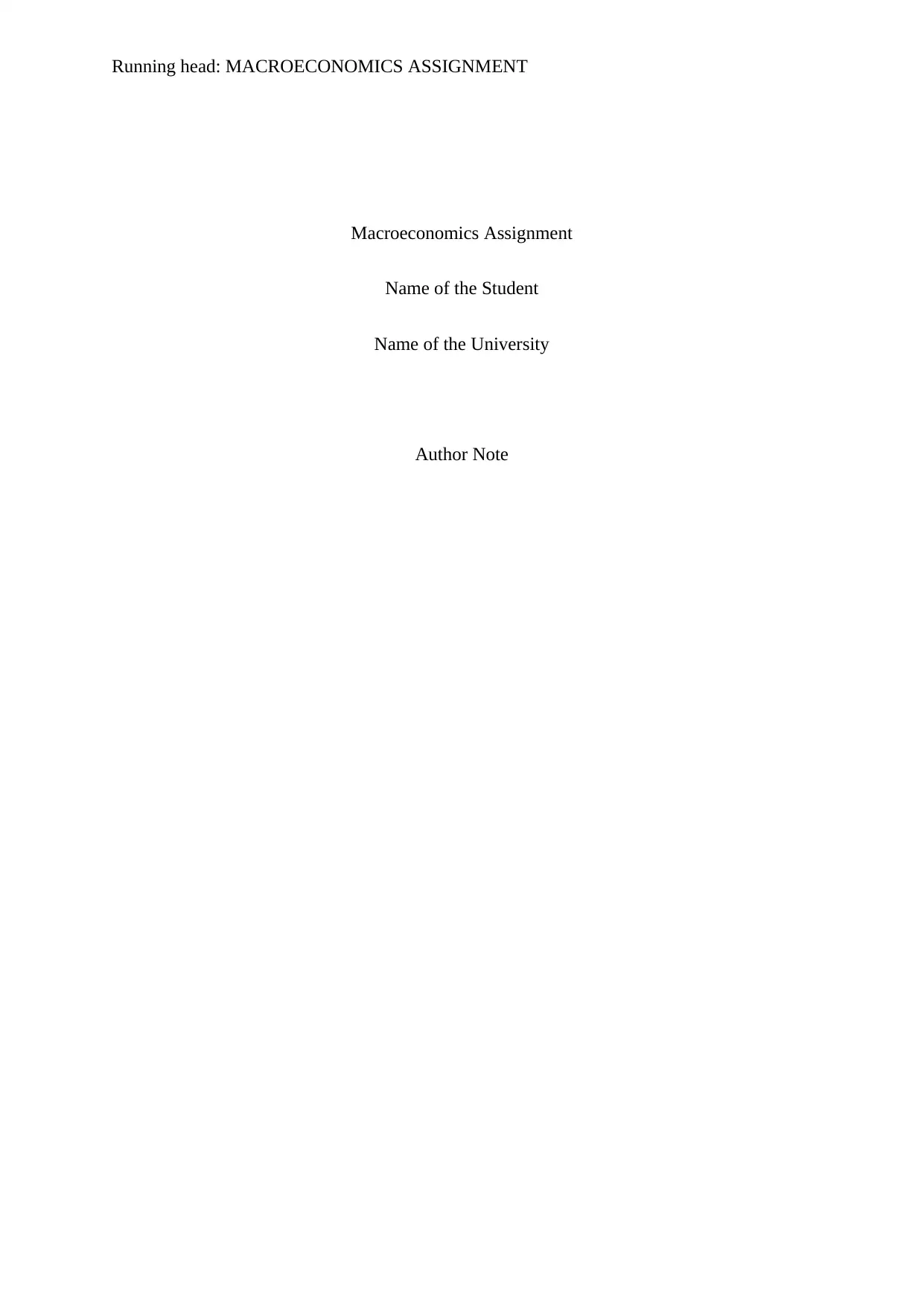
Running head: MACROECONOMICS ASSIGNMENT
Macroeconomics Assignment
Name of the Student
Name of the University
Author Note
Macroeconomics Assignment
Name of the Student
Name of the University
Author Note
Paraphrase This Document
Need a fresh take? Get an instant paraphrase of this document with our AI Paraphraser
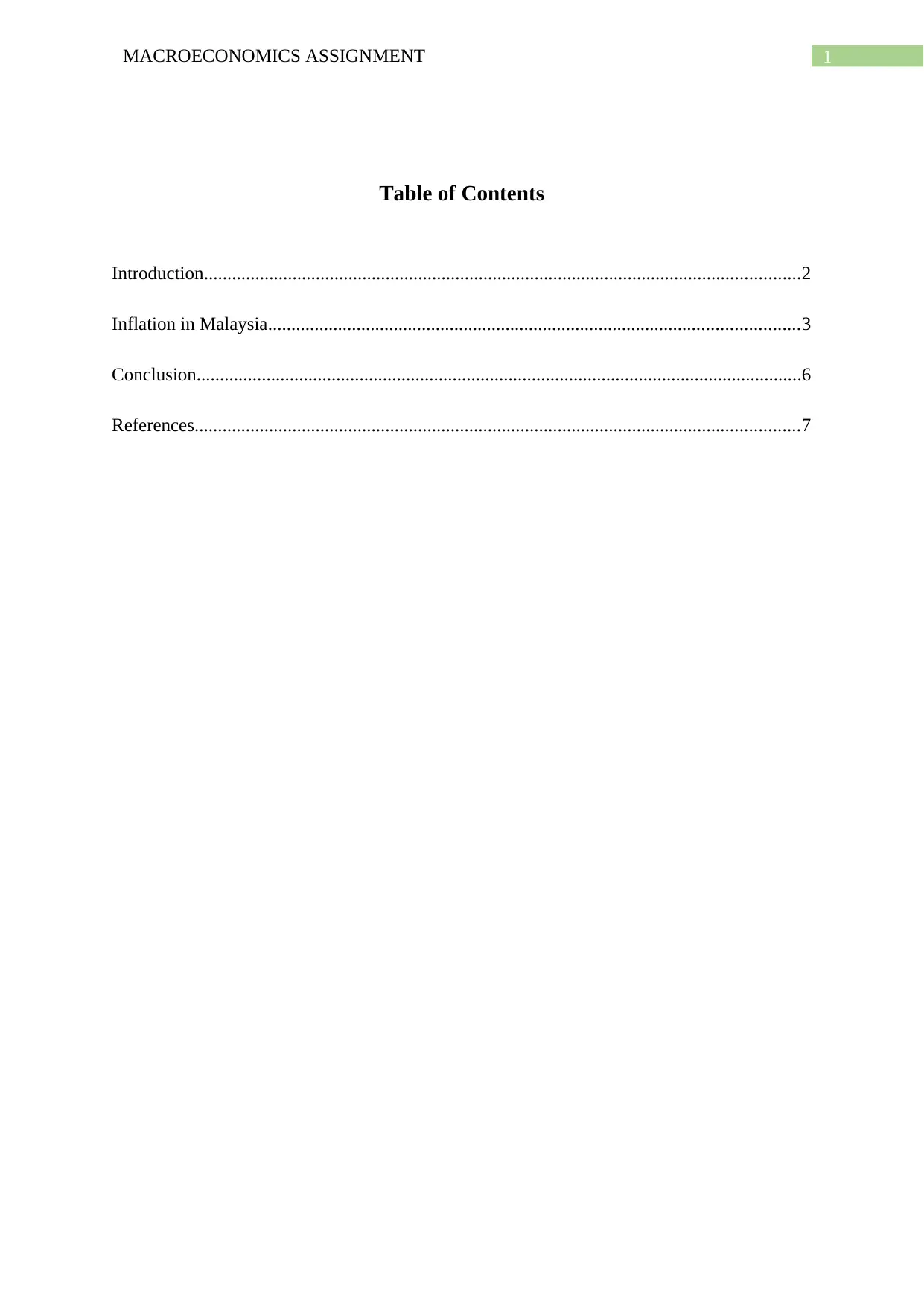
1MACROECONOMICS ASSIGNMENT
Table of Contents
Introduction................................................................................................................................2
Inflation in Malaysia..................................................................................................................3
Conclusion..................................................................................................................................6
References..................................................................................................................................7
Table of Contents
Introduction................................................................................................................................2
Inflation in Malaysia..................................................................................................................3
Conclusion..................................................................................................................................6
References..................................................................................................................................7
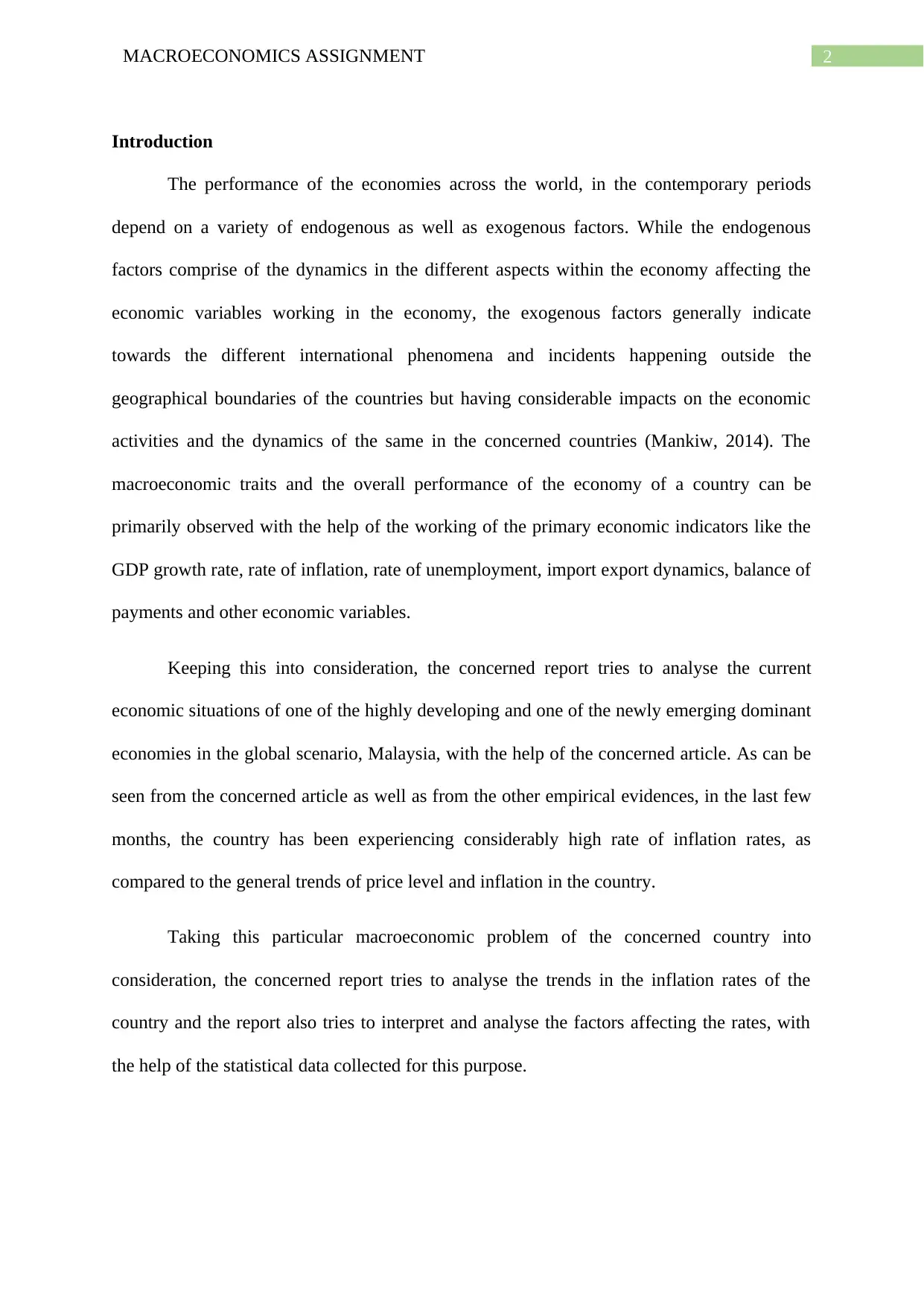
2MACROECONOMICS ASSIGNMENT
Introduction
The performance of the economies across the world, in the contemporary periods
depend on a variety of endogenous as well as exogenous factors. While the endogenous
factors comprise of the dynamics in the different aspects within the economy affecting the
economic variables working in the economy, the exogenous factors generally indicate
towards the different international phenomena and incidents happening outside the
geographical boundaries of the countries but having considerable impacts on the economic
activities and the dynamics of the same in the concerned countries (Mankiw, 2014). The
macroeconomic traits and the overall performance of the economy of a country can be
primarily observed with the help of the working of the primary economic indicators like the
GDP growth rate, rate of inflation, rate of unemployment, import export dynamics, balance of
payments and other economic variables.
Keeping this into consideration, the concerned report tries to analyse the current
economic situations of one of the highly developing and one of the newly emerging dominant
economies in the global scenario, Malaysia, with the help of the concerned article. As can be
seen from the concerned article as well as from the other empirical evidences, in the last few
months, the country has been experiencing considerably high rate of inflation rates, as
compared to the general trends of price level and inflation in the country.
Taking this particular macroeconomic problem of the concerned country into
consideration, the concerned report tries to analyse the trends in the inflation rates of the
country and the report also tries to interpret and analyse the factors affecting the rates, with
the help of the statistical data collected for this purpose.
Introduction
The performance of the economies across the world, in the contemporary periods
depend on a variety of endogenous as well as exogenous factors. While the endogenous
factors comprise of the dynamics in the different aspects within the economy affecting the
economic variables working in the economy, the exogenous factors generally indicate
towards the different international phenomena and incidents happening outside the
geographical boundaries of the countries but having considerable impacts on the economic
activities and the dynamics of the same in the concerned countries (Mankiw, 2014). The
macroeconomic traits and the overall performance of the economy of a country can be
primarily observed with the help of the working of the primary economic indicators like the
GDP growth rate, rate of inflation, rate of unemployment, import export dynamics, balance of
payments and other economic variables.
Keeping this into consideration, the concerned report tries to analyse the current
economic situations of one of the highly developing and one of the newly emerging dominant
economies in the global scenario, Malaysia, with the help of the concerned article. As can be
seen from the concerned article as well as from the other empirical evidences, in the last few
months, the country has been experiencing considerably high rate of inflation rates, as
compared to the general trends of price level and inflation in the country.
Taking this particular macroeconomic problem of the concerned country into
consideration, the concerned report tries to analyse the trends in the inflation rates of the
country and the report also tries to interpret and analyse the factors affecting the rates, with
the help of the statistical data collected for this purpose.
⊘ This is a preview!⊘
Do you want full access?
Subscribe today to unlock all pages.

Trusted by 1+ million students worldwide
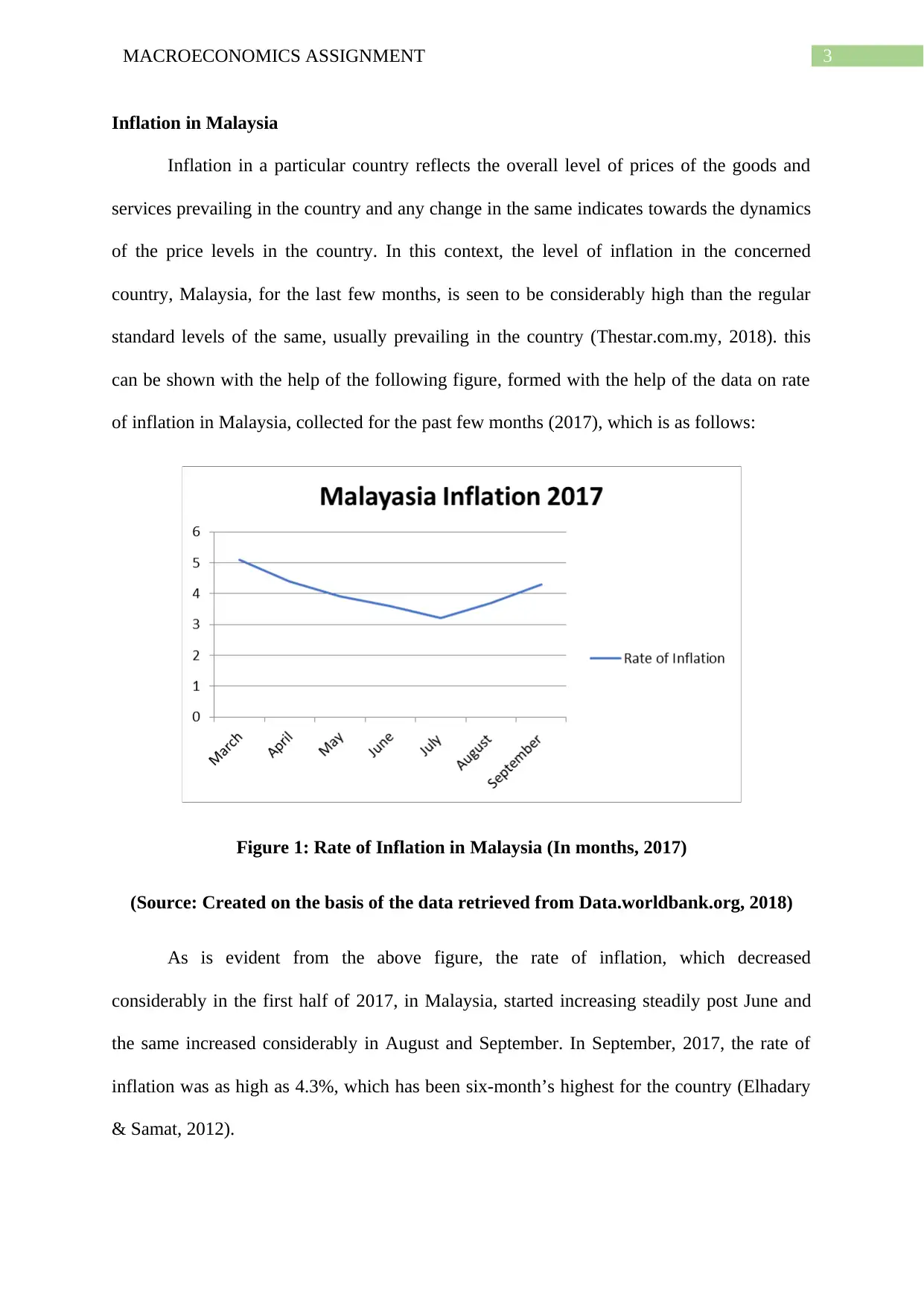
3MACROECONOMICS ASSIGNMENT
Inflation in Malaysia
Inflation in a particular country reflects the overall level of prices of the goods and
services prevailing in the country and any change in the same indicates towards the dynamics
of the price levels in the country. In this context, the level of inflation in the concerned
country, Malaysia, for the last few months, is seen to be considerably high than the regular
standard levels of the same, usually prevailing in the country (Thestar.com.my, 2018). this
can be shown with the help of the following figure, formed with the help of the data on rate
of inflation in Malaysia, collected for the past few months (2017), which is as follows:
Figure 1: Rate of Inflation in Malaysia (In months, 2017)
(Source: Created on the basis of the data retrieved from Data.worldbank.org, 2018)
As is evident from the above figure, the rate of inflation, which decreased
considerably in the first half of 2017, in Malaysia, started increasing steadily post June and
the same increased considerably in August and September. In September, 2017, the rate of
inflation was as high as 4.3%, which has been six-month’s highest for the country (Elhadary
& Samat, 2012).
Inflation in Malaysia
Inflation in a particular country reflects the overall level of prices of the goods and
services prevailing in the country and any change in the same indicates towards the dynamics
of the price levels in the country. In this context, the level of inflation in the concerned
country, Malaysia, for the last few months, is seen to be considerably high than the regular
standard levels of the same, usually prevailing in the country (Thestar.com.my, 2018). this
can be shown with the help of the following figure, formed with the help of the data on rate
of inflation in Malaysia, collected for the past few months (2017), which is as follows:
Figure 1: Rate of Inflation in Malaysia (In months, 2017)
(Source: Created on the basis of the data retrieved from Data.worldbank.org, 2018)
As is evident from the above figure, the rate of inflation, which decreased
considerably in the first half of 2017, in Malaysia, started increasing steadily post June and
the same increased considerably in August and September. In September, 2017, the rate of
inflation was as high as 4.3%, which has been six-month’s highest for the country (Elhadary
& Samat, 2012).
Paraphrase This Document
Need a fresh take? Get an instant paraphrase of this document with our AI Paraphraser
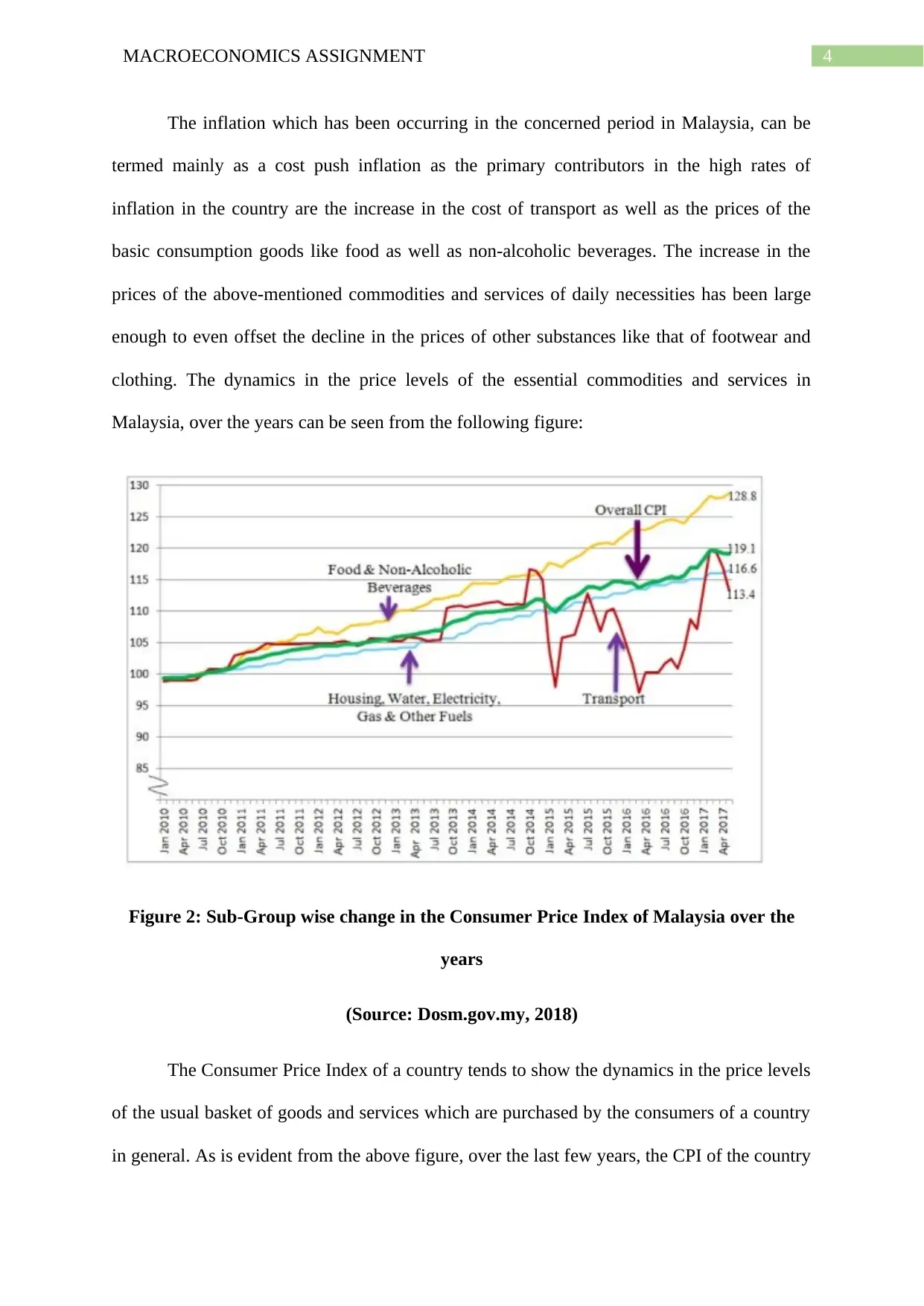
4MACROECONOMICS ASSIGNMENT
The inflation which has been occurring in the concerned period in Malaysia, can be
termed mainly as a cost push inflation as the primary contributors in the high rates of
inflation in the country are the increase in the cost of transport as well as the prices of the
basic consumption goods like food as well as non-alcoholic beverages. The increase in the
prices of the above-mentioned commodities and services of daily necessities has been large
enough to even offset the decline in the prices of other substances like that of footwear and
clothing. The dynamics in the price levels of the essential commodities and services in
Malaysia, over the years can be seen from the following figure:
Figure 2: Sub-Group wise change in the Consumer Price Index of Malaysia over the
years
(Source: Dosm.gov.my, 2018)
The Consumer Price Index of a country tends to show the dynamics in the price levels
of the usual basket of goods and services which are purchased by the consumers of a country
in general. As is evident from the above figure, over the last few years, the CPI of the country
The inflation which has been occurring in the concerned period in Malaysia, can be
termed mainly as a cost push inflation as the primary contributors in the high rates of
inflation in the country are the increase in the cost of transport as well as the prices of the
basic consumption goods like food as well as non-alcoholic beverages. The increase in the
prices of the above-mentioned commodities and services of daily necessities has been large
enough to even offset the decline in the prices of other substances like that of footwear and
clothing. The dynamics in the price levels of the essential commodities and services in
Malaysia, over the years can be seen from the following figure:
Figure 2: Sub-Group wise change in the Consumer Price Index of Malaysia over the
years
(Source: Dosm.gov.my, 2018)
The Consumer Price Index of a country tends to show the dynamics in the price levels
of the usual basket of goods and services which are purchased by the consumers of a country
in general. As is evident from the above figure, over the last few years, the CPI of the country
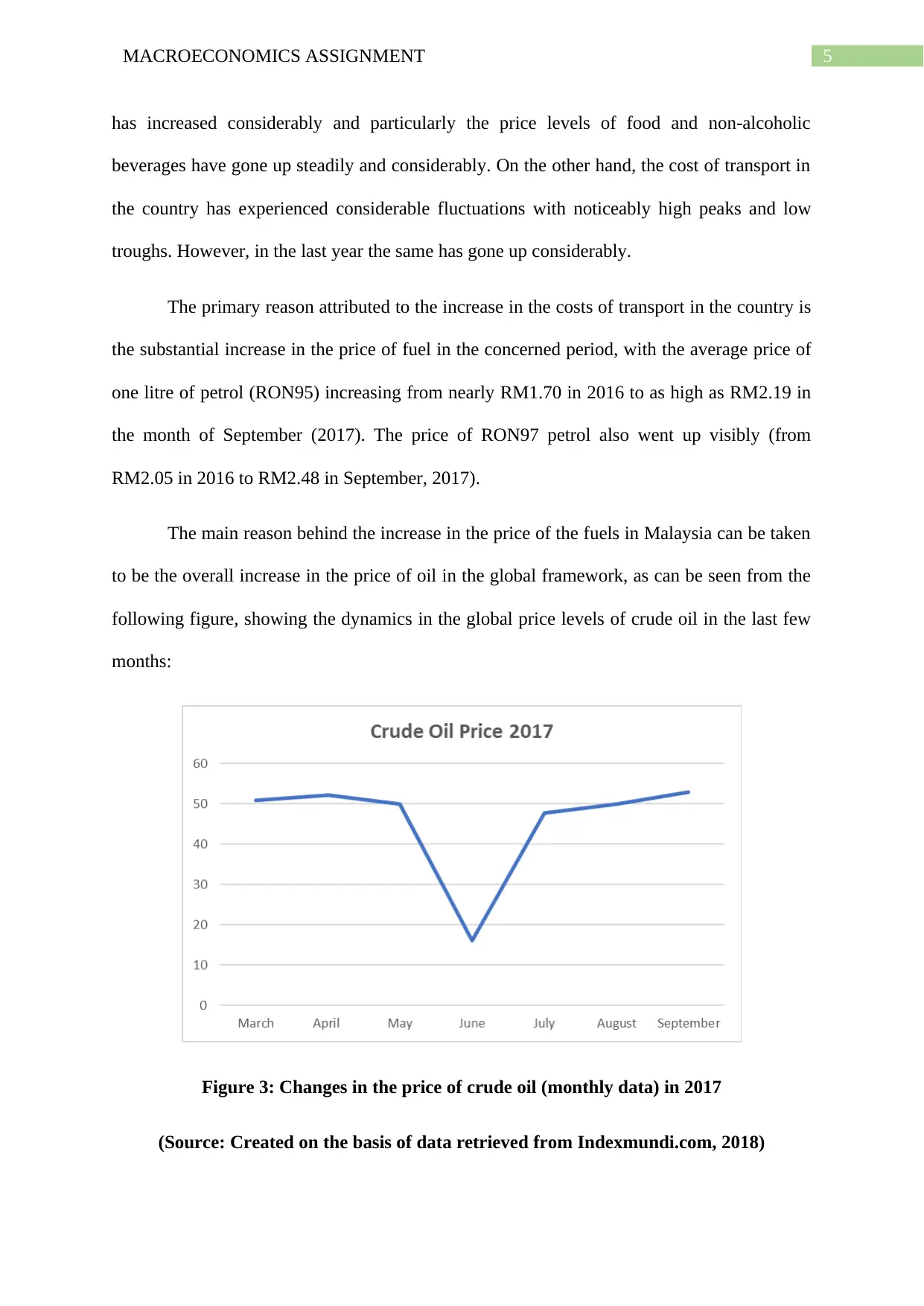
5MACROECONOMICS ASSIGNMENT
has increased considerably and particularly the price levels of food and non-alcoholic
beverages have gone up steadily and considerably. On the other hand, the cost of transport in
the country has experienced considerable fluctuations with noticeably high peaks and low
troughs. However, in the last year the same has gone up considerably.
The primary reason attributed to the increase in the costs of transport in the country is
the substantial increase in the price of fuel in the concerned period, with the average price of
one litre of petrol (RON95) increasing from nearly RM1.70 in 2016 to as high as RM2.19 in
the month of September (2017). The price of RON97 petrol also went up visibly (from
RM2.05 in 2016 to RM2.48 in September, 2017).
The main reason behind the increase in the price of the fuels in Malaysia can be taken
to be the overall increase in the price of oil in the global framework, as can be seen from the
following figure, showing the dynamics in the global price levels of crude oil in the last few
months:
Figure 3: Changes in the price of crude oil (monthly data) in 2017
(Source: Created on the basis of data retrieved from Indexmundi.com, 2018)
has increased considerably and particularly the price levels of food and non-alcoholic
beverages have gone up steadily and considerably. On the other hand, the cost of transport in
the country has experienced considerable fluctuations with noticeably high peaks and low
troughs. However, in the last year the same has gone up considerably.
The primary reason attributed to the increase in the costs of transport in the country is
the substantial increase in the price of fuel in the concerned period, with the average price of
one litre of petrol (RON95) increasing from nearly RM1.70 in 2016 to as high as RM2.19 in
the month of September (2017). The price of RON97 petrol also went up visibly (from
RM2.05 in 2016 to RM2.48 in September, 2017).
The main reason behind the increase in the price of the fuels in Malaysia can be taken
to be the overall increase in the price of oil in the global framework, as can be seen from the
following figure, showing the dynamics in the global price levels of crude oil in the last few
months:
Figure 3: Changes in the price of crude oil (monthly data) in 2017
(Source: Created on the basis of data retrieved from Indexmundi.com, 2018)
⊘ This is a preview!⊘
Do you want full access?
Subscribe today to unlock all pages.

Trusted by 1+ million students worldwide
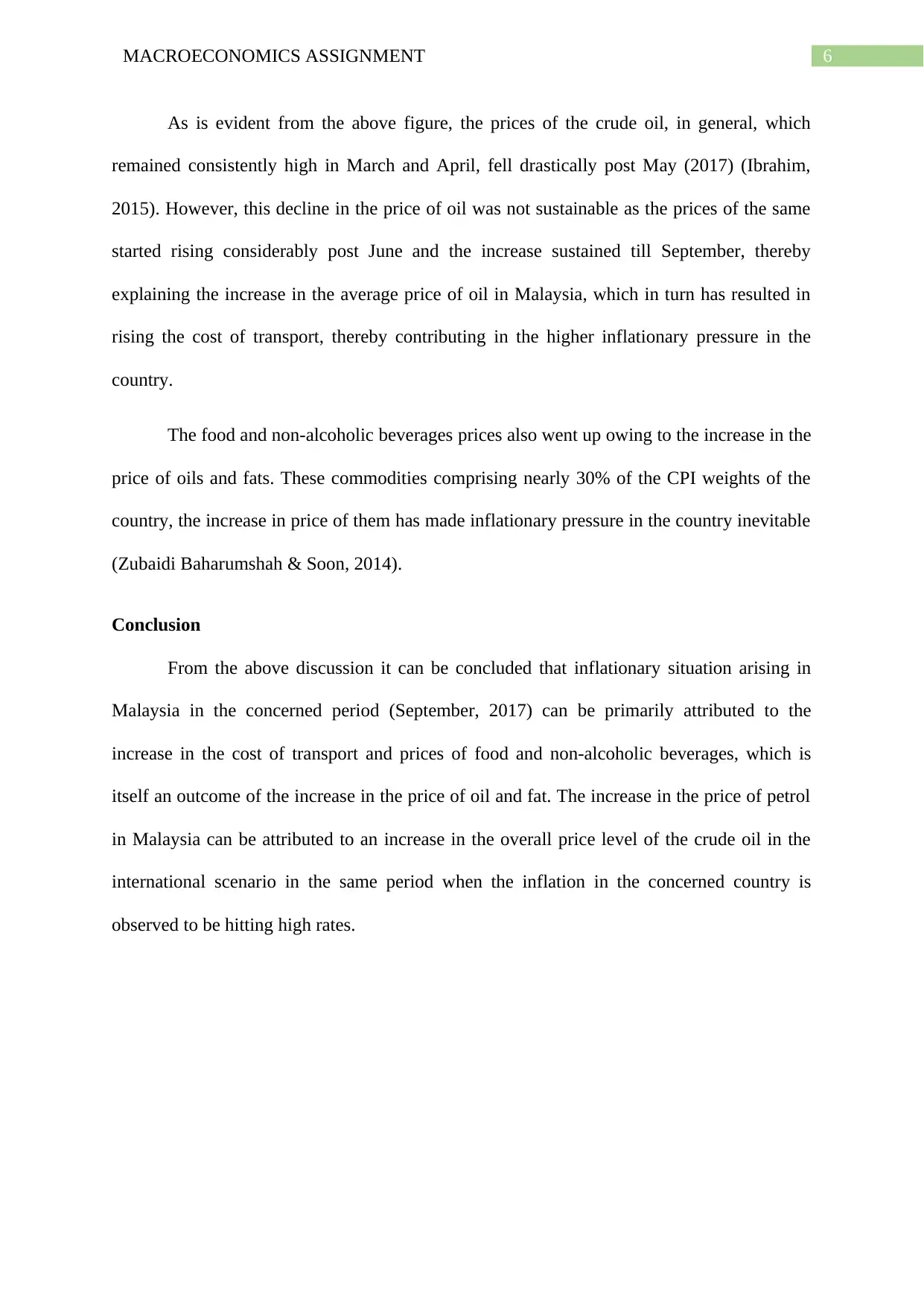
6MACROECONOMICS ASSIGNMENT
As is evident from the above figure, the prices of the crude oil, in general, which
remained consistently high in March and April, fell drastically post May (2017) (Ibrahim,
2015). However, this decline in the price of oil was not sustainable as the prices of the same
started rising considerably post June and the increase sustained till September, thereby
explaining the increase in the average price of oil in Malaysia, which in turn has resulted in
rising the cost of transport, thereby contributing in the higher inflationary pressure in the
country.
The food and non-alcoholic beverages prices also went up owing to the increase in the
price of oils and fats. These commodities comprising nearly 30% of the CPI weights of the
country, the increase in price of them has made inflationary pressure in the country inevitable
(Zubaidi Baharumshah & Soon, 2014).
Conclusion
From the above discussion it can be concluded that inflationary situation arising in
Malaysia in the concerned period (September, 2017) can be primarily attributed to the
increase in the cost of transport and prices of food and non-alcoholic beverages, which is
itself an outcome of the increase in the price of oil and fat. The increase in the price of petrol
in Malaysia can be attributed to an increase in the overall price level of the crude oil in the
international scenario in the same period when the inflation in the concerned country is
observed to be hitting high rates.
As is evident from the above figure, the prices of the crude oil, in general, which
remained consistently high in March and April, fell drastically post May (2017) (Ibrahim,
2015). However, this decline in the price of oil was not sustainable as the prices of the same
started rising considerably post June and the increase sustained till September, thereby
explaining the increase in the average price of oil in Malaysia, which in turn has resulted in
rising the cost of transport, thereby contributing in the higher inflationary pressure in the
country.
The food and non-alcoholic beverages prices also went up owing to the increase in the
price of oils and fats. These commodities comprising nearly 30% of the CPI weights of the
country, the increase in price of them has made inflationary pressure in the country inevitable
(Zubaidi Baharumshah & Soon, 2014).
Conclusion
From the above discussion it can be concluded that inflationary situation arising in
Malaysia in the concerned period (September, 2017) can be primarily attributed to the
increase in the cost of transport and prices of food and non-alcoholic beverages, which is
itself an outcome of the increase in the price of oil and fat. The increase in the price of petrol
in Malaysia can be attributed to an increase in the overall price level of the crude oil in the
international scenario in the same period when the inflation in the concerned country is
observed to be hitting high rates.
Paraphrase This Document
Need a fresh take? Get an instant paraphrase of this document with our AI Paraphraser
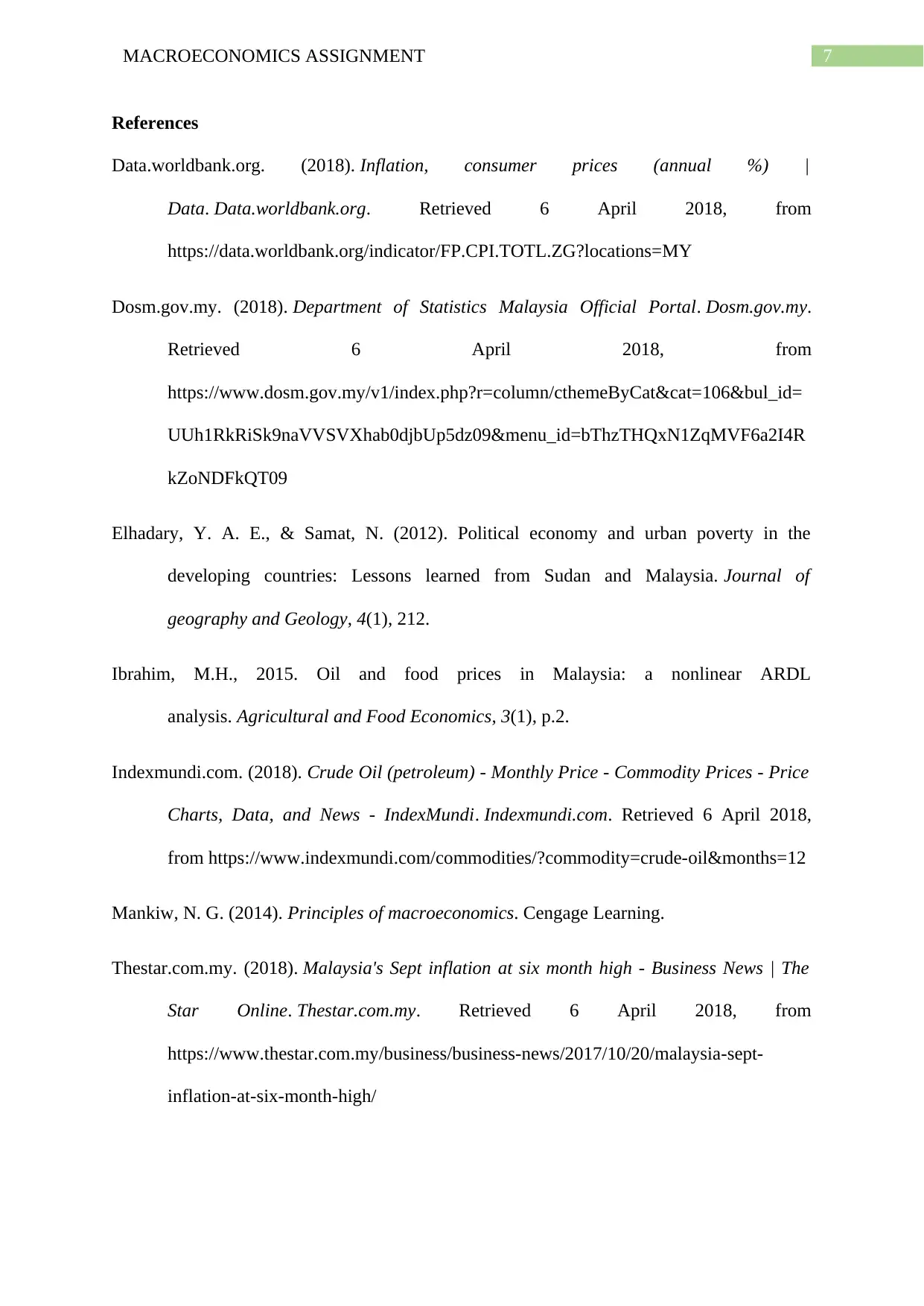
7MACROECONOMICS ASSIGNMENT
References
Data.worldbank.org. (2018). Inflation, consumer prices (annual %) |
Data. Data.worldbank.org. Retrieved 6 April 2018, from
https://data.worldbank.org/indicator/FP.CPI.TOTL.ZG?locations=MY
Dosm.gov.my. (2018). Department of Statistics Malaysia Official Portal. Dosm.gov.my.
Retrieved 6 April 2018, from
https://www.dosm.gov.my/v1/index.php?r=column/cthemeByCat&cat=106&bul_id=
UUh1RkRiSk9naVVSVXhab0djbUp5dz09&menu_id=bThzTHQxN1ZqMVF6a2I4R
kZoNDFkQT09
Elhadary, Y. A. E., & Samat, N. (2012). Political economy and urban poverty in the
developing countries: Lessons learned from Sudan and Malaysia. Journal of
geography and Geology, 4(1), 212.
Ibrahim, M.H., 2015. Oil and food prices in Malaysia: a nonlinear ARDL
analysis. Agricultural and Food Economics, 3(1), p.2.
Indexmundi.com. (2018). Crude Oil (petroleum) - Monthly Price - Commodity Prices - Price
Charts, Data, and News - IndexMundi. Indexmundi.com. Retrieved 6 April 2018,
from https://www.indexmundi.com/commodities/?commodity=crude-oil&months=12
Mankiw, N. G. (2014). Principles of macroeconomics. Cengage Learning.
Thestar.com.my. (2018). Malaysia's Sept inflation at six month high - Business News | The
Star Online. Thestar.com.my. Retrieved 6 April 2018, from
https://www.thestar.com.my/business/business-news/2017/10/20/malaysia-sept-
inflation-at-six-month-high/
References
Data.worldbank.org. (2018). Inflation, consumer prices (annual %) |
Data. Data.worldbank.org. Retrieved 6 April 2018, from
https://data.worldbank.org/indicator/FP.CPI.TOTL.ZG?locations=MY
Dosm.gov.my. (2018). Department of Statistics Malaysia Official Portal. Dosm.gov.my.
Retrieved 6 April 2018, from
https://www.dosm.gov.my/v1/index.php?r=column/cthemeByCat&cat=106&bul_id=
UUh1RkRiSk9naVVSVXhab0djbUp5dz09&menu_id=bThzTHQxN1ZqMVF6a2I4R
kZoNDFkQT09
Elhadary, Y. A. E., & Samat, N. (2012). Political economy and urban poverty in the
developing countries: Lessons learned from Sudan and Malaysia. Journal of
geography and Geology, 4(1), 212.
Ibrahim, M.H., 2015. Oil and food prices in Malaysia: a nonlinear ARDL
analysis. Agricultural and Food Economics, 3(1), p.2.
Indexmundi.com. (2018). Crude Oil (petroleum) - Monthly Price - Commodity Prices - Price
Charts, Data, and News - IndexMundi. Indexmundi.com. Retrieved 6 April 2018,
from https://www.indexmundi.com/commodities/?commodity=crude-oil&months=12
Mankiw, N. G. (2014). Principles of macroeconomics. Cengage Learning.
Thestar.com.my. (2018). Malaysia's Sept inflation at six month high - Business News | The
Star Online. Thestar.com.my. Retrieved 6 April 2018, from
https://www.thestar.com.my/business/business-news/2017/10/20/malaysia-sept-
inflation-at-six-month-high/

8MACROECONOMICS ASSIGNMENT
Zubaidi Baharumshah, A., & Soon, S. V. (2014). Inflation, inflation uncertainty and output
growth: what does the data say for Malaysia?. Journal of Economic Studies, 41(3),
370-386.
Zubaidi Baharumshah, A., & Soon, S. V. (2014). Inflation, inflation uncertainty and output
growth: what does the data say for Malaysia?. Journal of Economic Studies, 41(3),
370-386.
⊘ This is a preview!⊘
Do you want full access?
Subscribe today to unlock all pages.

Trusted by 1+ million students worldwide
1 out of 9
Related Documents
Your All-in-One AI-Powered Toolkit for Academic Success.
+13062052269
info@desklib.com
Available 24*7 on WhatsApp / Email
![[object Object]](/_next/static/media/star-bottom.7253800d.svg)
Unlock your academic potential
Copyright © 2020–2025 A2Z Services. All Rights Reserved. Developed and managed by ZUCOL.





